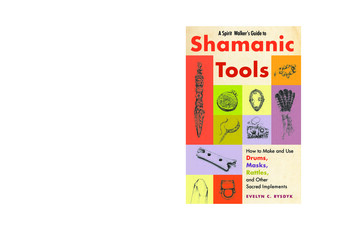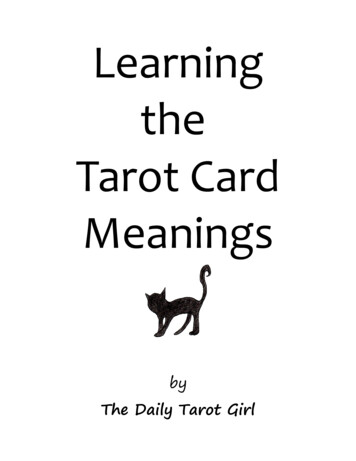
Transcription
In this beautifully illustrated guide, artist and shamanic teacherEvelyn C. Rysdyk shows you how to create, decorate, consecrate, and usevarious sacred tools in ritual and healing.smoke together with songs and dances to affect healing. Ulchi shamans use drums,rattles, and larch tree wands called gimsacha to work healing magic. Manchushamans will perfume the air with incense and tie on a heavy bustle of iron jinglesas a part of their ceremonial costume. Modern shamanic practitioners likewiseuse sacred tools to facilitate our connection to helper spirits in the Upper, Middle,and Lower Worlds, as well as the spirits of nature. While you can purchase manyof these tools, there’s nothing quite as powerful as making your own. You’ll findinstructions for making rattles, drums, masks, mirrors, spirit figures, fans, bells,pouches, wands, prayer bundles, flutes, whistles, and more. Plus suggestions forresponsible ways to obtain the materials you’ll need.“ Having an intimate connection to all the spirits that cametogether in my favorite rattle—knowing that the tiny pebblescame from the local riverbank, the wood handle from a lightning-struck maple in my yard, and the rawhide from a blackbear that was hunted by a native friend for food—gives ita far deeper meaning and power.”—from the introductiontools appear throughout the book.www.redwheelweiser.comISBN: 978-1-57863-557-3U.S. 21.95ToolsThe author’s original artwork and photographs of shamans and their authenticA Spirit Walker’s Guide to ShamanicNavajo traditional healers bring rattles, corn pollen, eagle feathers, and sageRYSDYKBuild Your Own Shamanic ToolkitA Spirit Walker’s Guide toShamanicToolsHow to Make and UseDrums,Masks,Rattles,and OtherSacred ImplementsE V E LY N C . R Y S D Y K
Praise for A Spirit Walker’sGuide to Shamanic Tools“ W hat I love about listening to Evelyn Rysdyk discuss shamanism isher ability to combine ancient lore with modern science so seamlessly that you would swear you can’t have one without the other.With the lyrical voice of an artist she taps into our memories of old,‘forgotten’ ways and helps us understand them in terms of the latest findings in physics, psychology, and ecology. She is a wonderfulguide for spirit walking between the worlds. Walk with her.”— To m Cowa n, author of Fire in the Head and Yearning forthe Wind“ An inspiring and critically important work, this book helps you useall of the spiritual tools and connections you were born with, butmost likely forgot. Spirit Walking clearly explains what shamanismis and does, while teaching in a concise, step-by-step fashion how tobring this way of being into your everyday life. I loved that I couldfeel the profound wisdom of many years of experience flow throughEvelyn’s writing in such a personal way. It feels like she is teachingyou directly, with all her deeply rooted energy and spirit guidedwords. Whether you are new to shamanism, or are living this wayof life already, you will find this book a valuable resource. At a timewhen life can seem so crazy, we need to become Spirit Walkers now,more than ever!”— Co lle en Dea t sma n, author of The Hollow Bone: A FieldGuide to Shamanism and Seeing in the Dark: Claim Your OwnShamanic Power Now and in the Coming Age.SpiritWalkerPages.indd 14/13/14 11:57 PM
“ In our ever-changing world many people have felt lost and isolatedwithin their lives, this statement is growing faster than we cankeep up. Through Evelyn’s Spirit Walking her grace and gifts areexpressed to shift our connection to the earth, each other, and ourselves, building the foundation for life in a new and different world.She is an exceptional writer, artist, healer and human ‘being.’”—Joa n Emmons, publisher of Inner Tapestry“ Evelyn Rysdyk brings the reader face to face with the bones of reality—how it works in this Middle World—and how the practice ofshamanism helps us to live in good relationship with All That Is.Embracing the venerable world-view of shamanism she compassionately guides readers on their own journey of discovery andempowerment within the reality of an ensouled Universe. SpiritWalking is comprehensive and inspiring—Evelyn’s outstanding artistry is evocatively expressed through her writings as well as images.A most worthy read!”— Na n Mo ss a n d Dav id Cor bin, authors of Weather Shamanism: Harmonizing Our Connection with the Elements“ Evelyn Rysdyk has written an invaluable shamanic resource thatis at once expansive and concise. She shares her deep wisdom withhumility and great generosity of spirit.”— M a ma Don na Hen es, urban shaman, author, and spiritualitycolumnist for the Huffington Post, Beliefnet and UPI“ Life is a sacred work how easy it is to forget that in the rush ofdaily life! And how wonderful it is when a book like [Spirit Walking] comes along, not only reminding us of our deepest sense ofconnection and purpose, but offering wise guidance to help us getback to it.”— Hil l a r y S. Webb, author of Traveling between the Worlds:Conversations with Contemporary ShamansSpiritWalkerPages.indd 24/13/14 11:57 PM
First published in 2014 by Weiser BooksRed Wheel/Weiser, l lcWith offices at:665 Third Street, Suite 400San Francisco, CA 94107www.redwheelweiser.comAll illustrations, photographs, and text 2014 by Evelyn C. Rysdyk unlessotherwise noted. All rights reserved. No part of this publication may bereproduced or transmitted in any form or by any means, electronic ormechanical, including photocopying, recording, or by any informationstorage and retrieval system, without permission in writing from RedWheel/Weiser, llc. Reviewers may quote brief passages.ISBN: 978-1-57863-557-3Library of Congress Cataloging-in-Publication Data available uponrequest.Cover design by Jim Warner.Cover art Evelyn C. Rysdyk.Interior by Maureen Forys, Happenstance Type-O-RamaTypeset in Warnock Pro and FuturaPrinted in Canada.MAR10 9 8 7 6 5 4 3 2 1SpiritWalkerPages.indd 64/13/14 11:57 PM
DisclaimerThis book does not replace formal instruction in shamanicspirituality. It is necessary for you to know how to journey andhave a strong connection to a power animal or teacher beforeyou work with this book.To learn more about shamanic journeying and developingrelationships with the helpful, healing spirits, please read SpiritWalking: A Course in Shamanic Power.The suggestions, processes, and shamanic techniquesdescribed in this book are in no way meant to replace professional medical or mental health assistance. This book isintended to be an informational guide and not to treat, diagnose, or prescribe. Always consult with a qualified health careprofessional regarding any medical or mental health conditionor symptoms. Neither the author nor the publisher accepts anyresponsibility for your health or how you choose to use theinformation contained in this book.SpiritWalkerPages.indd 124/13/14 11:57 PM
IntroductionThis volume was specifically designed to support thoseof you who have learned how to access the spirit realmsthrough the shaman’s journey and desire to add the right spiritual implements to your shamanic toolkit. If you picked upthis book and don’t yet know how to journey, you may learnwhat you need via several methods. There are several excellent books available that can guide you through the practice.Two outstanding resources for learning the shamanic journeyprocess are my own book, Spirit Walking: A Course in Shamanic Power, and Sandra Ingerman’s Shamanic Journeying: ABeginner’s Guide. In addition, there are many teachers availableto support you in person. The website www.shamanicteachers.com has a l ist of authorities across North America, Europe,and Australia. Information on my own initiatory shamanictraining programs is available at www.spiritpassages.com.Spirit Passages is the organization I founded with my partner,Allie Knowlton, MSW, LCSW, DCSW to support individuals increase their personal power, feel their intrinsic sacredness, and expand their connections to All That Is. Howeveryou learn, take the time to strengthen your connections to thespirits prior to attempting the spiritual exercises in this book.Learning to journey and having strong relationships witha teacher in the spirit world and with a protector spirit in theform of a p ower animal make up the basic framework forSpiritWalkerPages.indd 134/13/14 11:57 PM
any effective shamanic practice. People who have gained thisknowledge through their culture’s tribal traditions are typically referred to as shamans. I will mention several of thesetribal healers with whom I’ve been fortunate to study in thisbook. Their full biographies are available in an appendix.However, it is also possible for anyone without a tribal affiliation to become an effective shamanic practitioner or spiritwalker by entering into deep relationships with the spirits.The foundation of any powerful shamanic work is dependentupon the relationships forged with the helpful spirits in theUpper, Middle, and Lower Worlds. Journeying to meet withthe helpful spirits and following through with the guidancethey offer sustains these relationships. Engaging with the spirits of nature is another essential aspect of becoming a powerful spirit walker. This aspect of practice is supported throughjourneying to meet the spirits of the trees, animal, birds, andlandscape features around your home to find out who they areand what they might like to share. Just as with human connections, initial meetings blossom into reciprocal relationshipsthat nurture the spirit walker and support the health of thenatural world. My book Spirit Walking: A Course in ShamanicPower takes you through this process and provides the basicsfor becoming a truly powerful shamanic practitioner.Whether you are looking at your connections to helpingspirits or spirits of nature, you will find that certain objectsfacilitate those connections and support you to accomplishyour work more easily. For instance, the sacred sounds ofdrums, rattles, and other implements accompany your spiritjourneys. Power objects such as staffs, crystals, and masksamplify your intention, concretize that which is “invisible,” orprovide a stronger connection to power in your relationshipwith your helpful and healing spirits.Navajo traditional healers bring rattles, corn pollen, eaglefeathers, and sage smoke together with songs and dances toxivIntroductionSpiritWalkerPages.indd 144/13/14 11:57 PM
effect healing. An Ulchi shaman would need a drum, rattle,and larch wands called gimsacha to work healing magic. AManchu shaman would need to perfume the air with incenseand tie on a heavy bustle of iron jingles as a part of a ceremonial costume. Western-trained, core shamanic practitionersmay utilize many different forms of ritual objects. Often contemporary practitioners have also been trained in one or moreindigenous traditions which they incorporate as a part of theirhealing practice. The implements used are extensions of theshaman’s intention and power. They support and/or magnifythe connection with the helpful, healing spirits that guide theshaman’s actions.Archaeological evidence shows that we human beings havebeen making tools for at least 2.6 million years. Early in ourdevelopment, we discovered that certain objects could help usaccomplish tasks more easily. Our stone implements allowed usto hammer, drill, cut, and shape the details of our physical world.By 40,000 years ago, we were using our tools to craft sophisticated musical instruments, as well as in drawing, painting,and carving figurines that assisted us in expressing complexideas and our intangible feelings. Shamanic implements are anoutgrowth of this progression as they support us to go deeperinto the intangible worlds through journeys to the numinousrealms of spirit. There, we navigate the complex interrelationships that are continually creating our physical existence.My own early years were filled with an incredible array oftools, as my family elders were very creative. My mother andmy great uncle expressed their talents in traditional paintingsand drawings, but most of the others built structures, madehousehold goods, and created what they needed to make theirlives work. For them, tools were a part of solving the challengesof everyday life.As the eldest child, I was often the designated helper for myfather. Like others in my ancestral line, he was a creative manIntroductionSpiritWalkerPages.indd 15xv4/13/14 11:57 PM
gifted with his hands. Along with being an amazing automobile mechanic who designed and built cars from the groundup, he was very talented at welding, carpentry, and numerousother forms of craftsmanship. His tool chests were filled witha variety of wrenches, pliers, saws, calipers, and other highlyunique implements designed for very specific tasks. Throughobserving him at work, I quickly learned that these tools functioned like extensions of his hands. They assisted him in getting a job done.On the other hand, while in art school I met highly skilledartists who could use a common ballpoint pen to create a masterpiece. Learning this lesson was equally important as I realized that while the right tool makes a task easier, it is critical todevelop the skills to use each one first. Without the knowledgeto wield them, tools are no more than fancy paperweights.I have found the same to be true of shamanic implements.Finding the right drum will not make you a shaman. However,any drum in the hands of a skilled shamanic practitioner canbe an object of power. It becomes inspirited—alive—and capable of assisting in the spirit walker’s work. It provides the heartbeat of your journey, a way to accompany your spirit songs, aportal through which you can travel, and is capable of manyother roles in your practice. The same may be said for all theother objects used by a true spirit walker. Each of them has apurpose and has been enlivened to become active partners inthe shaman’s work.It is my belief that an extra dimension of power opens upwhen you craft your own tools. Working with the separate elements that will become the implement and the spirits in thoseelements deepens the spirit walker’s connections to the finalproduct. I a lso like knowing exactly what separate elementswent into my tools. For instance, I know that the tiny pebblesin my favorite rattle came from the local riverbank, the handleis wood harvested from a lightning-struck maple in my yard,xviIntroductionSpiritWalkerPages.indd 164/13/14 11:57 PM
and the rawhide was once part of a Maine black bear hunted bya native friend for food. My having an intimate connection toall the spirits that came together in my rattle gives it a deepermeaning and power.Of course, this is not to say that you have to make everything that you use in your shamanic practice! I use severalshamanic tools that were either purchased or given to meby one of my indigenous teachers. If any project in this bookseems too difficult, you may choose to purchase the implement discussed and then use the empowerment instructionsto enliven your new power object. Once empowered, any toolwill become a living partner in your work.This book is designed to support those of you who areactively journeying to gather what you require to effectivelyand powerfully engage with the spirits. I believe that those ofus following the shamanic path are the best hope for returningour human culture into wholeness. Spirit walkers know thateverything is alive and sentient. We understand that all beingsare precious and that we must consider their needs by staying in mutually beneficial relationships with them to maintainharmony. Through our journeys and with guidance from ourloving tutelary spirits, we are helping to shape a more positiveand healthy world.Ev el y n C . RysdykIntroductionSpiritWalkerPages.indd 17xvii4/13/14 11:57 PM
Chapter 1The RattleSince shamans receive much of their training and guidancefrom their tutelary spirits, the implements any particularshaman uses for healing are unique and usually vary widelyfrom one shaman to the next. Native shamans may be boundby their tribal traditions to use particular rituals and bringcertain objects into a healing ceremony, but even within thosespecific traditions many variations exist. Rattles are an important part of the shaman’s tool kit and widely used around theglobe. In this chapter you will find out how shamans work withrattles, and you will learn to create and empower your ownrawhide rattle.Some shamans use rattles much in the way drums wouldbe, that is, to accompany the shamanic journey and keepshamans in the expanded state of consciousness required toperform their duties. Lighter and more portable than a drum,rattles can be used in situations when a drum may not be thebest choice. For instance, a rattle is quieter and so may be theright implement when working indoors or when a softer soundwould be beneficial. Rattles are also a great choice for workingout in nature as they can be easily stashed in a backpack orcoat pocket until they are needed. I find that I reach for mySpiritWalkerPages.indd 14/13/14 11:57 PM
rattle as much as my drum to accompany my journeys. I oftenuse it when I am doing shamanic work outdoors around myhome so that I don’t disturb my neighbors. The rattle is also mypreferred shamanic instrument when I am engaging in healingwork as I can be continuously rattling to keep myself in theshamanic state of consciousness at the same time I am usingmy other hand to work on my client.A rawhide shaman’s rattle is the first implement I have mystudents make in my initiatory shamanic training programs.It is a relatively easy object to create for people of all levels ofcrafting experience. This is the kind of rattle you will be guidedthrough constructing in this chapter. However, there are asmany variations among rattles as there are among drums. Ihave personally seen rattles constructed from gourds, buffaloor steer horn, turtle shells, rawhide, birch bark, animal hooves,bones, wood, seashells, and seedpods, among other materials.Some shamans even use objects such as tin cans or bottle capsas part of their rattles!In North America, native tribal peoples use rattles extensively. In some cases the rattle replaces the drum as the primary shamanic instrument. Depending on the region, thesemay be made out of several different materials. Some rattlesare fashioned from dried gourds that have been hollowed out,filled with a few small stones or seeds, and secured on a stick.Variations on this type of rattle are seen among the Northernand Eastern Woodlands, Plains, Southwestern, Californian,and Southern tribes of Native Americans. Especially largeexamples of these gourd rattles are made by the Hopi and otherPueblo peoples of the American Southwest. Some of the finestHopi ceremonial rattles have been crafted from gourds with around and slightly flattened shape like a fat disk. Usually verycolorfully painted in combinations of white, black, yellow, red,turquoise, and green, these rattles have a feather secured by astring to the very top which flies around as the rattle is shaken.2A Spirit Walker’s Guide to Shamanic ToolsSpiritWalkerPages.indd 24/13/14 11:57 PM
Among the native people of the Great Plains of the UnitedStates, the gourds used are smaller and placed on a longer stick.Although these peoples traditionally leave the gourd head ofthe rattle undecorated, the handles are usually covered indesigns of very beautiful and intricate beadwork.1 Like thepueblo-style rattles, they too end in a feather at the top andoften have a horsehair tail at the base of the handle. These elements add extra movement to the shaman’s rattling gestures.The southern Pacific Coast and southwestern tribal peoples ofthe United States use gourd-shell rattles that are decorated byboring tiny holes across the surface of the head which have theeffect of slightly amplifying the rattle’s sound.2Gourd rattles of the Cherokee utilize the neck of the gourdto create a handle. The gourd is carefully sliced at the base ofthe neck, the insides of the gourd are removed, pebbles areinserted, and then the neck is replaced with a small plug ofwood providing a support to the joint. These rattles can bequite eccentrically shaped, based on the form in which thegourd originally grew.Among the Guarani people of the Amazon forest, the rattleor ubaraka mri, is the tool the shaman uses to “communicatewith god.” The round gourd part of the rattle is seen as a womband the handle as a penis. As such, the structure of the rattlehelps to maintain the overall balance between masculine andfeminine energies. Like the Hopi examples, these rattles alsohave feathers attached at the top that flutter as the rattle isshaken.3I have held examples of African rattles that had heads madefrom a gourd with a forked stick for a handle. Wire was strungbetween the forked ends of the handle, and flattened bottle capshad been pierced and strung along the entire wire’s length. Thisdesign makes a very effective rattle with a wonderfully loud,clashing sound when shaken, thanks to the combined nature ofthe sounds of the gourd and bottle caps. Indeed, as is the caseThe RattleSpiritWalkerPages.indd 334/13/14 11:57 PM
with many Siberian and central Asian shamanic drumbeaters, the extra jingles produce a fine rhythmic rattling sound toaccompany the shaman’s work.In places where gourds were not as common and theweather is damp, the native peoples turned other local materials to create their ceremonial rattles. The Woodland tribesfamous for utilizing the magnificently beautiful bark of birchtrees for food containers, storage vessels, and even theircanoes also reached for this material in making their rattles.Using the bark from fallen trees, a cylinder is sewn togetherwith the white or outside of the bark turned to the inside.A circular top and bottom were then fashioned and sewn tothe ends of the tube after pebbles or dried corn kernels wereplaced inside. This made a shape somewhat like a tin can. Ahole was then bored through the top and bottom ends so thata stick could be passed through the rattle and secured. Hornrattles are made in this same manner by simply replacing thebirch bark tube with a section of buffalo or steer horn. TheEastern Woodlands people are known for their rattles madeof turtle shells. Beautiful examples of these may be foundat powwows across New England and into eastern Canada.Using the empty turtle shell as the container for pebbles orseeds, these rattles sometimes incorporate an actual turtlehead as a part of the rattle.Among the people of North America’s Pacific Coast, woodhas also been the primary resource for making a shaman’srattle. Surrounded by the enormous trees of the temperaterain forest, these peoples are known for utilizing wood in botheveryday and sacred objects as well as for their extraordinarilyfine carvings. Originally the shaman’s rattles were round inoverall shape and carved over their surface with images of theshaman’s spiritual helpers.4Sometimes the figures that form the rattle are quite fiercefaced. These effigy-like carvings may be empowered by the4A Spirit Walker’s Guide to Shamanic ToolsSpiritWalkerPages.indd 44/13/14 11:57 PM
shaman so that they become extensions of the shaman’s poweror function as partners during healing work. Other NorthwestCoast rattles are quite elaborately carved into the shape of theanimals they represent and often also carefully painted. Particularly fine examples of these figure rattles are found amongthe Tlingit people. Rattles have been carved to resemble oystercatchers, ravens, bears, and other totemic animals. A dearfriend who is a shamanic practitioner in Quebec uses a particularly fine example of this type of rattle in her healing practice.She works with Raven, and the rattle is carved in a wonderfullystylized image of this spirit’s head.Figure 1. Tsimshian shaman’s rattle. (Pen and ink 2013 Evelyn C. Rysdyk)The RattleSpiritWalkerPages.indd 554/13/14 11:57 PM
Animal rawhide is another common material for rattlemaking. Rawhide becomes very flexible when soaked in waterand can be easily shaped while in that pliable state. Once dry,the rawhide becomes quite hard again and provides a n icesound. The most commonly seen rawhide rattle is created bysewing wet rawhide into a sack or container-like shape, whichis filled with sand to hold its form until dry. Once the headof the rattle is hard again, the resulting hollow is emptied ofsand, filled with seeds, beads, crystals, or pebbles, and securedto a handle. This basic formula can be used to make rattlesof many different shapes. The Sioux of the Great Plains andOjibwa of the northern central woodlands of the United Statesand southern Canada often make rattles in a shape similar tomaracas. The latter people sometimes pierce their rattle headsin the manner of the Papago tribe of the Sonoran Desert.In truth, rattles have been made from just about anythingthat produces noise, even pieces of antler, deer hooves, puffinbeaks, and bones. Shamans have ingeniously exploited everyavailable resource to provide the sounds necessary to supporttheir journeys into the spirit realms.Exercise: Making a Rawhide RattleTo become an effective shamanic practitioner or spirit walker,it is important to take opportunities to concretize the lessonsyou receive from spirit. When a spiritual lesson is manifestedin this reality, it allows you to more fully internalize what youhave learned. You will feel the work more deeply and strengthenthe connections with your helping spirits.Indeed, performing a ceremony such as making a gratitudeoffering or honoring the spirits of the natural world supportsyou in becoming more powerful. Another method for makingthe spiritual experience more physical is to create some of theobjects you will be using as a spirit walker. This is one of the6A Spirit Walker’s Guide to Shamanic ToolsSpiritWalkerPages.indd 64/13/14 11:57 PM
reasons I have always included making objects in Spirit Passages training programs.While you may have many other shamanic implements overthe course of your life, the simple rattle you will create in thisexercise can become a powerful part of your practice. I havemany rattles that I have purchased—most of which are moreelegantly made than my own. However, the one that I craftedmyself has become so empowered through my constructingand using it that its efficacy for me far exceeds the others.Materials and Toolsee A piece of rawhide about twelve inches square and aneighth of an inch thickee A stick for a handleee Sandpaperee A PDF file of the full-sized, full-color rattle pattern andinstructions found here may be downloaded at www.myspiritwalk.com (Print out two copies of your pattern andset one aside. This second copy will be a useful reference forthe project in chapter 2.)ee A soft pencilee A good, sharp pair of scissorsee A push awl or sharp nail the same thickness as your needleee A hammeree A rectangular piece of scrap plywood or other flat board suchas a secondhand cutting board about ten to twelves inches orso across (You will be putting holes in this piece.)ee A spool of artificial sinewee A needle that is big enough to thread the sinewThe RattleSpiritWalkerPages.indd 774/13/14 11:57 PM
ee Two large skeins of natural, undyed, thick wool knittingyarn or wool roving (unspun wool that has been cleanedand combed)ee An embroidery hook to remove wool when the rattle is dryee One teaspoon or two of very tiny pebbles (one-sixteenth toone-eighth of an inch in diameter)ee White glueee Drill and one-eighth-inch drill bitee Small scrap of deerskin or other soft leatheree Paint, beads, feathers, and other things you may want to useto decorate your finished rattleee A shamanic journey drumming recording with callbacksignal to facilitate your journeys to the spirits of the hideand handle as well as for empowering the rattle once it iscompletedRawhide is the scraped and dried hide of an animal. It is typically used for drumheads and may be found through companies that supply drum-making supplies. Commercial rawhideis usually from a steer, but it is possible to find deer, elk, goat,and even black bear rawhide through online sources. In apinch, the larger ten-inch rawhide dog chews with the knot ateach end may be used for a rattle. Choose only the unflavoredvariety to make your rattle!Take time to pick out a handle stick with meaning for youand prepare it by sanding it smooth. If you are close to the oceanyou may wish to use driftwood. Perhaps a beaver stick from apond or river may appeal to you. You may ask your favorite treefor a small branch. Maybe you have a treasured piece of woodfrom building a house or piece of furniture. Even a dowel fromthe hardware store can be decorated to feel “just right!”8A Spirit Walker’s Guide to Shamanic ToolsSpiritWalkerPages.indd 84/13/14 11:57 PM
Figure 2. Rawhide rattle patternMake the Rattle1. Begin by gathering all of your tools and ingredients. Taketime to make thoughtful choices. In planning a t ime toactually construct your rattle, remember that your piece ofrawhide will have to be soaked in water overnight for it tobe pliable.The RattleSpiritWalkerPages.indd 994/13/14 11:57 PM
2. While your rawhide soaks, you have the opportunity tosand and decorate your handle. Before you begin, performan offering to thank all the spirits who are participatingin the project with you. These include the animal whosehide you will be using, the tree from which the stick hascome, and so on. Your offering can be as simple as burningincense while holding these spirits in your mind or placinga bit of cornmeal outside while saying your thanks aloud.Or you can reference the more extensive instructions inSpirit Walking: A Course in Shamanic Power. By enteringinto a prayerful state, you are inviting the spirits to participate with you. You may then wish to journey to find outwhat imagery or colors would be best for the handle. I liketo use a wood-burning tool
relationships with the helpful, healing spirits, please read Spirit Walking: A Course in Shamanic Power. The suggestions, processes, and shamanic techniques described in this book are in no way meant to replace pro-fessional medical or mental health assistance. This book is inte










